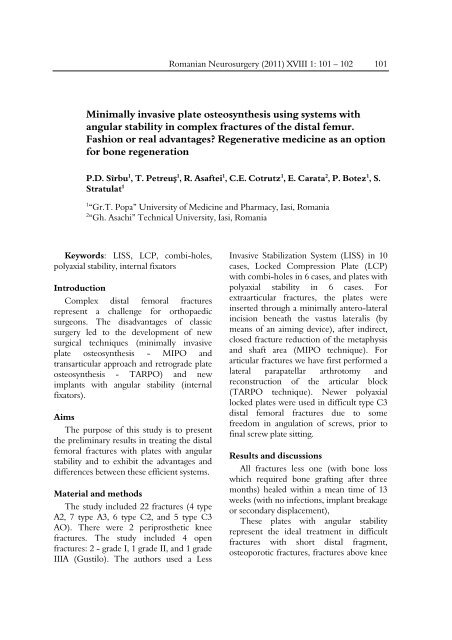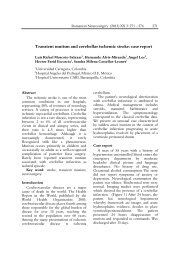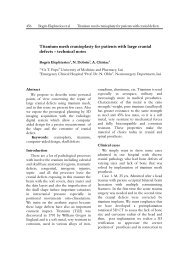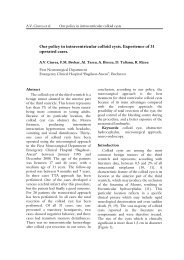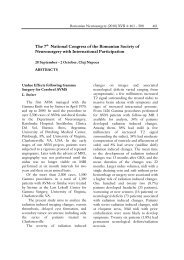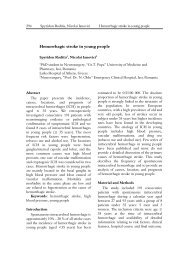Minimally invasive plate osteosynthesis using systems with angular ...
Minimally invasive plate osteosynthesis using systems with angular ...
Minimally invasive plate osteosynthesis using systems with angular ...
Create successful ePaper yourself
Turn your PDF publications into a flip-book with our unique Google optimized e-Paper software.
Romanian Neurosurgery (2011) XVIII 1: 101 – 102 101<br />
<strong>Minimally</strong> <strong>invasive</strong> <strong>plate</strong> <strong>osteosynthesis</strong> <strong>using</strong> <strong>systems</strong> <strong>with</strong><br />
<strong>angular</strong> stability in complex fractures of the distal femur.<br />
Fashion or real advantages Regenerative medicine as an option<br />
for bone regeneration<br />
P.D. Sîrbu 1 , T. Petreuș 1 , R. Asaftei 1 , C.E. Cotrutz 1 , E. Carata 2 , P. Botez 1 , S.<br />
Stratulat 1<br />
1 “Gr.T. Popa” University of Medicine and Pharmacy, Iasi, Romania<br />
2 “Gh. Asachi” Technical University, Iasi, Romania<br />
Keywords: LISS, LCP, combi-holes,<br />
polyaxial stability, internal fixators<br />
Introduction<br />
Complex distal femoral fractures<br />
represent a challenge for orthopaedic<br />
surgeons. The disadvantages of classic<br />
surgery led to the development of new<br />
surgical techniques (minimally <strong>invasive</strong><br />
<strong>plate</strong> <strong>osteosynthesis</strong> - MIPO and<br />
transarticular approach and retrograde <strong>plate</strong><br />
<strong>osteosynthesis</strong> - TARPO) and new<br />
implants <strong>with</strong> <strong>angular</strong> stability (internal<br />
fixators).<br />
Aims<br />
The purpose of this study is to present<br />
the preliminary results in treating the distal<br />
femoral fractures <strong>with</strong> <strong>plate</strong>s <strong>with</strong> <strong>angular</strong><br />
stability and to exhibit the advantages and<br />
differences between these efficient <strong>systems</strong>.<br />
Material and methods<br />
The study included 22 fractures (4 type<br />
A2, 7 type A3, 6 type C2, and 5 type C3<br />
AO). There were 2 periprosthetic knee<br />
fractures. The study included 4 open<br />
fractures: 2 - grade I, 1 grade II, and 1 grade<br />
IIIA (Gustilo). The authors used a Less<br />
Invasive Stabilization System (LISS) in 10<br />
cases, Locked Compression Plate (LCP)<br />
<strong>with</strong> combi-holes in 6 cases, and <strong>plate</strong>s <strong>with</strong><br />
polyaxial stability in 6 cases. For<br />
extraarticular fractures, the <strong>plate</strong>s were<br />
inserted through a minimally antero-lateral<br />
incision beneath the vastus lateralis (by<br />
means of an aiming device), after indirect,<br />
closed fracture reduction of the metaphysis<br />
and shaft area (MIPO technique). For<br />
articular fractures we have first performed a<br />
lateral parapatellar arthrotomy and<br />
reconstruction of the articular block<br />
(TARPO technique). Newer polyaxial<br />
locked <strong>plate</strong>s were used in difficult type C3<br />
distal femoral fractures due to some<br />
freedom in angulation of screws, prior to<br />
final screw <strong>plate</strong> sitting.<br />
Results and discussions<br />
All fractures less one (<strong>with</strong> bone loss<br />
which required bone grafting after three<br />
months) healed <strong>with</strong>in a mean time of 13<br />
weeks (<strong>with</strong> no infections, implant breakage<br />
or secondary displacement),<br />
These <strong>plate</strong>s <strong>with</strong> <strong>angular</strong> stability<br />
represent the ideal treatment in difficult<br />
fractures <strong>with</strong> short distal fragment,<br />
osteoporotic fractures, fractures above knee
102 P.D. Sîrbu et al <strong>Minimally</strong> <strong>invasive</strong> <strong>plate</strong> <strong>osteosynthesis</strong><br />
arthroplasties and some open fractures. The<br />
key to success for internal fixators are:<br />
correct/incorrect indications, the usage of<br />
the appropriate <strong>plate</strong>s, proper fracture<br />
reduction before <strong>plate</strong> insertion and screw<br />
drilling, avoidance of the eccentric <strong>plate</strong>s<br />
placement, full-weight bearing allowed<br />
when callus is seen in serial postoperative<br />
radiographs. The authors prefer the LCP<br />
system and a newer polyaxial locked <strong>plate</strong><br />
due to their advantages of screw pathway<br />
adjustment.<br />
Conclusions<br />
Close cooperation between orthopaedic<br />
surgeon, biomechanics specialist and the<br />
departments of cell biology and pathology,<br />
will contribute to the development of the<br />
ideal internal fixator and will sustain the<br />
future experimental investigations in order<br />
to elucidate the dynamic and coherent<br />
process of callus formation <strong>with</strong> these<br />
biological <strong>plate</strong>s and techniques.<br />
References<br />
1. Frigg R., Appenzeller A, Christensen R., Frenk A,<br />
Gilbert S., Schavan R. “The development of the distal<br />
femur. Less Invasive Stabilization System (LISS)”,<br />
Injury, Int. J. Care Injured, 2001, 32, pp. 24-31.<br />
2. Wagner M, Frigg R (eds) AO Manual of fracture<br />
management – Internal Fixators. Thieme Stuttgart<br />
(2006)<br />
3. Richter M, Droste P, Goesling T, Zech S, Krettek C.<br />
- Polyaxially-locked <strong>plate</strong> screws increase stability of<br />
fracture fixation in an experimental model of calcaneal<br />
fracture. J Bone Joint Surg Br. 2006 Sep;88(9):1257-63.<br />
4. Sirbu P.D., Schwarz N., Belangero V.D., Livani B.,<br />
List M., Botez P., Mihaila R.I. <strong>Minimally</strong> <strong>invasive</strong> <strong>plate</strong><br />
ostheosynthesis in long bone fractures, Casa de Editura<br />
Venus, Iasi, Romania 2008.<br />
5. Sirbu P.D., Friedl W., Botez P., Stratan L., Hopulele<br />
S., Asaftei R. Osteosinteza minim invaziva cu placi -<br />
Fixatoare interne, Casa de Editura Venus, Iasi, Romania<br />
2008<br />
6. Ip David, Orthopedic Traumatology – A Resident’s<br />
Guide; Springer Berlin-Heidelberg 2006


